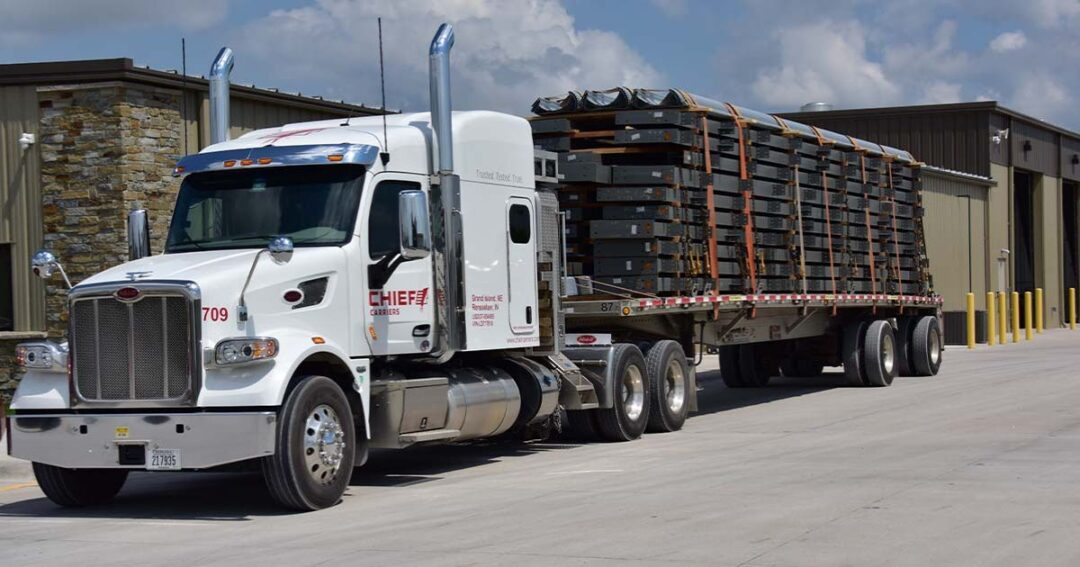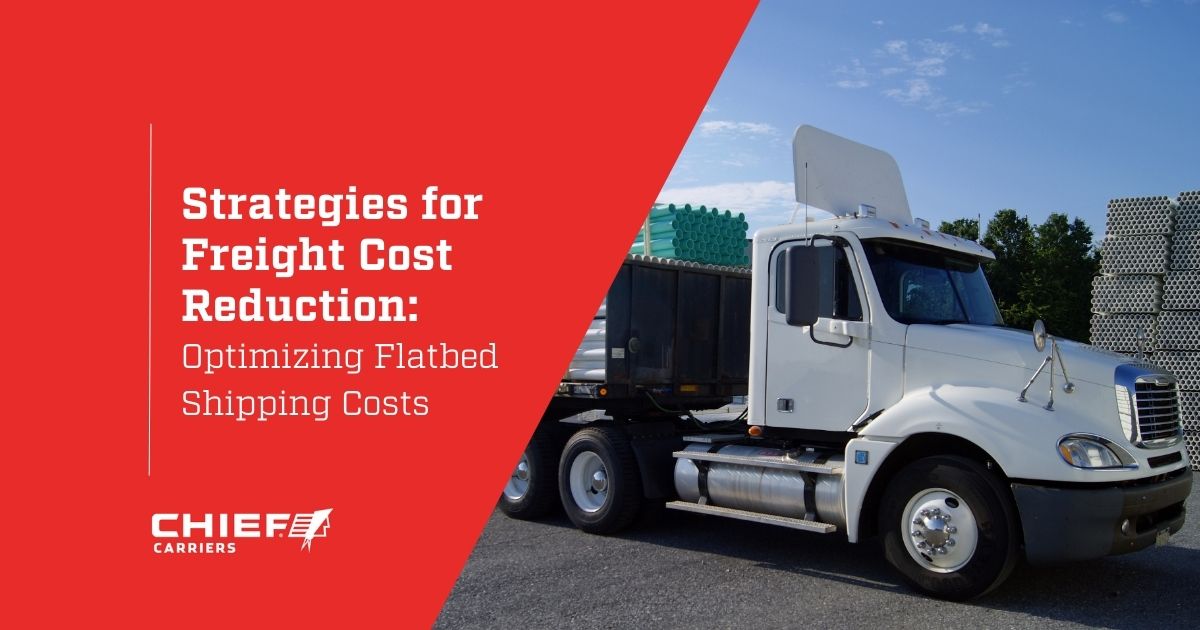If you’re a shipper, controlling shipping costs is a common pain point that impacts your bottom line and competitive edge. In today’s dynamic market conditions, freight cost reduction is more than just a goal; it’s necessary for your business. Efficient operations, streamlined logistics, and strategic planning are crucial for minimizing your freight expenses and maximizing your profitability.
At Chief Carriers, we have over 50 years of expertise in providing tailored shipping solutions, and we understand the challenges of managing expenses. We’ll explore practical and effective strategies for optimizing your flatbed shipping costs for significant freight cost reduction. We provide the information you need to navigate the complexities of freight shipping with confidence.
Understanding Flatbed Freight Rates and Their Impact
To effectively reduce costs, you must understand the factors influencing flatbed freight rates. These rates are not static; they fluctuate based on various elements that all play a significant role in shipping costs.
- Fuel prices: The cost of fuel directly impacts transportation expenses.
- Transport distances: Moving freight over longer distances naturally increases fuel consumption and driver time.
- Cargo type: Specialized cargo that requires unique handling or securement drives up the complexity and overall cost of transporting.
- Seasonal variations and market fluctuations: Increased demand during peak construction seasons can drive up flatbed freight rates.
- Load size and weight: Heavier and larger loads require more specialized equipment and fuel, leading to higher expenses.

Practical Strategies for Freight Cost Reduction
Efficient trucking operation is the cornerstone of any successful freight cost reduction strategy. Here are practical strategies to help you optimize your flatbed shipping:
Efficient Load Planning: How to Optimize Load Dimensions for Shipping Costs
Load planning refers to strategically organizing and arranging cargo within a trailer to maximize space utilization, ensure safety, and optimize delivery efficiency. This involves considering factors like the size, weight, and type of cargo, as well as the route and delivery schedule, to minimize transportation costs and prevent damage during transit.
You can incorporate the following strategies to make load planning more efficient, which reduces flatbed shipping costs.
- Optimizing dimensions and weight: By reducing wasted space and weight, you minimize the resources required for each shipment and lower shipping costs.
- Securing loads properly: Ensuring loads are correctly secured reduces the risk of damage, delays, and additional costs, while ensuring safety and improving transportation efficiency.
- Consolidating shipments: Shipping multiple smaller loads together reduces the number of individual shipments and associated expenses.
Route Optimization
Efficient route optimization is a critical strategy for freight cost reduction. Shippers can significantly minimize fuel consumption and transit times by meticulously planning the most effective paths, leading to lower overall expenses.
This process involves analyzing various factors, including distance, traffic patterns, and delivery schedules, to determine the most economical and timely routes. Adapting to real-time conditions through route adjustments further enhances efficiency, preventing costly delays and ensuring timely deliveries.

Leveraging Technology for Freight Management
Technology plays a pivotal role in route efficiency and supply chain optimization. Transportation Management Systems (TMS) are tools that provide real-time tracking and data analytics for proactive adjustments and informed decision-making. These systems streamline processes, improve visibility, and facilitate data-driven strategies that pinpoint inefficiencies and opportunities for cost savings.
Digital documentation and communication also enhance efficiency by reducing paperwork and minimizing errors, resulting in a more streamlined and cost-effective supply chain.
Risk Management and Insurance: Reducing Flatbed Freight Rates through Proper Risk Mitigation
Unforeseen events, such as weather delays, accidents, or supply chain disruptions, can drastically inflate shipping costs. Implementing robust risk management strategies is therefore crucial. This includes:
- Securing comprehensive cargo insurance to protect against potential losses
- Developing thorough contingency plans to address unexpected challenges
- Proactively implementing measures to mitigate disruptions.
By anticipating and preparing for potential risks, shippers can minimize financial exposure and ensure the smooth, cost-effective flow of their goods.
Carrier Selection
Selecting seasoned carriers with a proven track record of efficient trucking solutions is essential for optimizing flatbed shipping. These trucking companies possess the knowledge, experience, and resources required for complex shipments, ensuring timely deliveries and minimizing potential disruptions. Their expertise extends to handling specialized flatbed cargo, adhering to stringent safety standards, and leveraging established networks to streamline logistics and achieve significant freight cost reduction.

Negotiation and Contract Review
Securing favorable flatbed freight rates can be achieved by conducting thorough market research, building strong, long-term carrier relationships, and strategically negotiating based on shipment volume and potential partnerships. Additionally, thoroughly reviewing contract terms and conditions prevents unexpected shipping costs by ensuring you have a complete understanding of all fees and charges.
Collaboration and Partnerships
Strategic collaboration across the supply chain, including partnerships with suppliers and distributors, can yield substantial freight cost reduction. Exploring resource-sharing alliances, even with competitors, can further optimize logistics and minimize redundancies. Fostering open communication and mutual benefit allows businesses to leverage collective strengths for a more efficient and cost-effective ecosystem.
Sustainability and Green Logistics
Eco-friendly practices, such as implementing fuel-efficient routing, maximizing load capacity to reduce trips, and exploring alternative fuels, not only contribute to a smaller carbon footprint but also drive significant freight cost reduction. By using these practices, businesses can lower fuel consumption, minimize emissions, and enhance brand image, aligning with consumer demands for responsible shipping solutions while simultaneously improving their bottom line.

Tips for Long-Term Freight Cost Management
To maintain a competitive edge and achieve long-term freight cost reduction, consistent effort and strategic adjustments are essential. Here are key practices to ensure continuous improvement and long-term savings:
- Conduct regular freight cost audits: Regularly review your shipping expenses to identify trends and areas for optimization.
- Stay up-to-date on industry trends and regulations: Staying informed helps you adapt to industry regulation changes and maintain compliance.
- Implement strategies for continuous improvement: Use best practices for transportation efficiency, leverage technology, and continuously seek ways to improve processes.
- Utilize shipping solutions for long-term savings: Implementing comprehensive solutions ensures sustained cost savings and efficiency.
Chief Carriers’ Expertise in Shipping Solutions
Chief Carriers, in collaboration with our sister division Chief Logistics, delivers effective shipping solutions for flatbed freight, focusing on custom strategies that optimize logistics and reduce flatbed shipping costs. Our leadership in flatbed trucking is reinforced by rigorous driver training, innovative safety programs, and comprehensive load securement education, ensuring secure and timely cargo delivery. By leveraging our extensive industry expertise, you can streamline your shipping processes for significant savings and overall operational efficiency.

Optimize Freight Shipping Costs for Your Business
Optimizing flatbed shipping costs for freight cost reduction requires a strategic and proactive approach to freight and supply chain management. You can significantly reduce your shipping expenses by understanding the factors that influence rates, implementing efficient load planning, optimizing routes, leveraging technology, and negotiating favorable contracts.
With over 50 years of experience, Chief Carriers is your trusted partner in providing comprehensive shipping solutions to help you achieve your freight cost reduction goals. Contact us today for personalized strategies and expert guidance to optimize your flatbed shipping operations.

